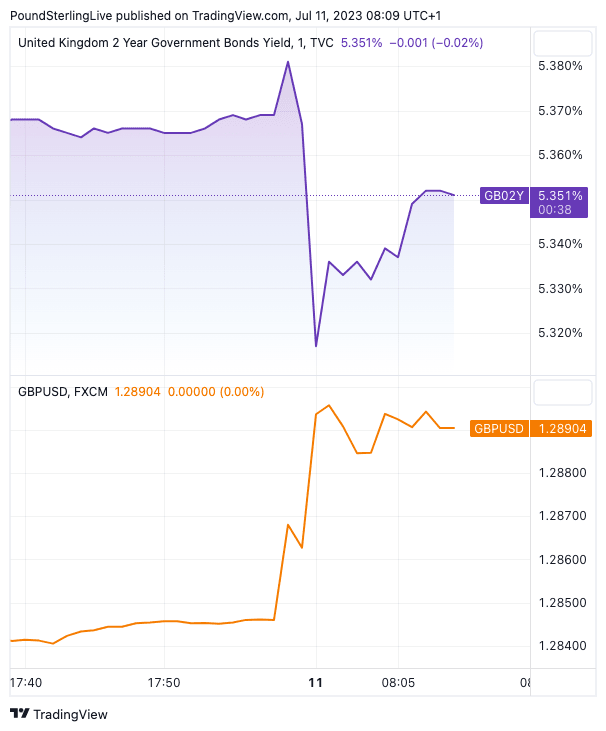Pound Hits New 2023 Best against Dollar After UK Jobs Report Lowers Bank of England Rate Hike Expectations
- Written by: Gary Howes
-
- GBPUSD rises to fresh 2023 high
- UK two-year bond yields fall
- As labour market data hints at increasing slack
- Suggests wage pressures to begin easing

Image © Adobe Images
UK bond yields fell and the Pound to Dollar conversion (GBPUSD) rallied to a new 2023 best at 1.2935 following the release of labour market data that hinted the Bank of England won't be required to push Bank Rate to above 6.0%.
The ONS reported that wage pressures remained acute and were likely to stimulate inflation further, but all other signals in the labour market survey pointed to a cooling jobs market and suggests wage pressures will ease over the coming months.
Indeed, the UK unemployment rate unexpectedly rose to 4.0% and job vacancies fell for the 12th consecutive month, suggesting it won't be long before wage pressures will come down enough to begin pressuring core inflation.
Pound Sterling's move higher following the labour market report would hint that the market is ready to welcome a retreat in Bank of England interest rate expectations from levels in excess of 6.0% as this lowers the risks of a deep interest-rate-induced recession.
Above: UK bond yields (top) fell and GBPUSD rose, suggesting the Pound likes that the market is lowering expectations for the UK interest rates outlook.
Pound-Dollar's ascent through 1.29 represents the best exchange rate for buyers of dollars since April 2022 and underscores a positive medium- and short-term technical trend.
"The high-yielding pound is now 6.6% stronger year-to-date against the softening U.S. dollar, with all eyes on whether $1.30 can be reclaimed," says George Vessey, FX and Macro Strategist at Convera.
The ONS reported its average earnings index, excluding bonuses, rose 7.3% in May, above the consensus expectation of 7.1%, and in line with April's 7.3%.
The average earnings index with bonuses included rose 6.9% in May, a touch higher than expectations at 6.8% and higher than April's 6.7%. Both data would suggest the UK continues to see wage settlements come in at very high levels that would be consistent with elevated domestic inflationary pressures and further rate hikes at the Bank of England.
But wages are a lagged economic indicator and evidence suggests wages will start falling.
"It always has taken a little time for changes in labour market slack to influence wage growth, and some leading indicators remain encouraging," says Samuel Tombs, Chief UK Economist at Pantheon Economics.
He cites the net balance of recruiters reporting that salaries are rising for new hires fell to a 26-month low in June, and now is slightly below its average in the second half of the 2010s, according to the Report on Jobs Survey.
"The slowdown in hiring will reduce job-to-job flows and thus squeeze the contribution to wage growth from labour market churn, as well as ease the pressure on employers to offer existing staff large wage rises," says Tombs.
Elsewhere, employment rose 102K in the three months to May, which represents an undershoot of the market's expected 125K and the 250K reported in April. The more timely claimant count showed those seeking out-of-work benefits rose 25.7K in June, ahead of the -8.6K expected and the -22.5K reported in May.
So while inflationary pressures are still evident in the wage data, the market is almost certainly turning, which should ease pressure on the Bank of England to raise interest rates.
"There were some tentative signs that the labour market may be turning, with the headline unemployment rate increasing to 4.0% in the three months to May, the highest since January 2022. But this has to be balanced against still persistently strong wage growth," says Ellie Henderson, an economist at Investec.
Yet UK interest rates will almost certainly end higher than elsewhere in the developed world, and likely stay higher for longer, offering the Pound residual support via the rates channel.
"Higher rates are enhancing sterling's already considerable carry advantage, even as the bar for further hawkish surprises relative to market pricing is now very high," says a research note from Barclays, "we have turned more positive on the GBP in the near term."











